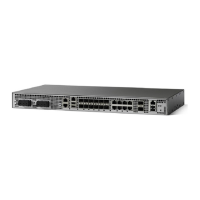•
What is the expected maximum size packet or maximum transmission unit (MTU) of the label
switched path?
•
What is the topology? What are the expected label switched paths? How many links in the label
switching path (LSP)? Trace the paths of the label switched packets including the paths for load
balancing.
•
Understand how to use MPLS and MPLS applications, including traffic engineering, Any Transport
over MPLS (AToM), and Label Distribution Protocol (LDP). You need to
•
Know how LDP is configured
•
Understand AToM concepts
•
Be able to troubleshoot a TE tunnel
•
Understand label switching, forwarding, and load balancing.
Restrictions for MPLS LSP Ping, Traceroute, and AToM VCCV
•
You cannot use MPLS LSP Traceroute to trace the path taken by Any Transport over Multiprotocol
Label Switching (AToM) packets. MPLS LSP Traceroute is not supported for AToM. (MPLS LSP Ping
is supported for AToM.) However, you can use MPLS LSP Traceroute to troubleshoot the Interior
Gateway Protocol (IGP) LSP that is used by AToM.
•
You cannot use MPLS LSP Ping or Traceroute to validate or trace MPLS Virtual Private Networks
(VPNs).
•
You cannot use MPLS LSP Traceroute to troubleshoot label switching paths (LSPs) that employ
time-to-live (TTL) hiding.
Information About MPLS LSP Ping, Traceroute, and AToM VCCV
MPLS LSP Ping Operation
MPLS LSP Ping uses Multiprotocol Label Switching (MPLS) echo request and reply packets to validate a
label switched path (LSP). Both an MPLS echo request and an MPLS echo reply are User Datagram Protocol
(UDP) packets with source and destination ports set to 3503.
The MPLS echo request packet is sent to a target device through the use of the appropriate label stack associated
with the LSP to be validated. Use of the label stack causes the packet to be switched inband of the LSP (that
is, forwarded over the LSP itself). The destination IP address of the MPLS echo request packet is different
from the address used to select the label stack. The destination address of the UDP packet is defined as a 127.x
.y .z /8 address. This prevents the IP packet from being IP switched to its destination if the LSP is broken.
An MPLS echo reply is sent in response to an MPLS echo request. It is sent as an IP packet and forwarded
using IP, MPLS, or a combination of both types of switching. The source address of the MPLS echo reply
packet is an address from the device generating the echo reply. The destination address is the source address
of the device in the MPLS echo request packet.
MPLS Basic Configuration Guide, Cisco IOS XE Everest 16.5.1 (Cisco ASR 900 Series)
64
MPLS LSP Ping, Traceroute, and AToM VCCV
Restrictions for MPLS LSP Ping, Traceroute, and AToM VCCV

